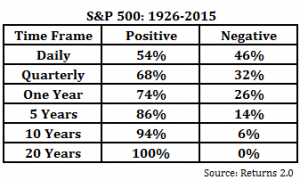Your Money Trailguide helping you pursue your great adventure now.
Continue readingQ3 Letter to Clients
Quarterly update to clients
Continue readingQuarterly Letter to Clients
Quarterly Letter to Clients
April 2020 – Quarterly Update: Covid-19 Edition
This will be the quarter that we look back on and never forget. It was the time that a virus spread with a silent vengeance, and the world came to a screeching halt. You may be feeling quite disoriented, fearful or even anxious as you read this note since ‘normal’ for all of us has been shaken to its core due to Covid-19. You are likely hunkering down at home, which is what you should do, with little of your regular activities to keep you busy. If you are like me, it literally feels like the earth has stopped spinning on its axis. Up is down, and right is left. Trust me when I say that it is completely normal to feel this way in the context of what we are dealing with as a human species.
I do not come to you with answers or any conclusions that will change the world…there are people that are much smarter than me working on that now, and I have confidence that they will figure it out. But I can bring some encouragement and suggest some small actions that might, just maybe, help us feel like planet earth is starting to rotate once again.
What can you do?
The spread of Covid-19 has impacted the global economy with a speed and impact that is unlike anything seen in our lifetime. This does not mean that happiness and contentment are totally out of your control, however. Mindset is key…start by realizing that the sun still rises every morning like the picture at the top of the article. There is new hope with each new day. I am sure you have found, as have I, that there is now more time to watch movies, read a book, take a distance-appropriate walk to enjoy the spring weather or call someone (yes, actually call them rather than text) to see how they are doing.
If you are sheltering at home with loved ones, you have probably seen them more in the last two weeks than you have for months. We should all continue to do more of these things, and the more we do, the more connected we will stay. I am not a loquacious extrovert, but I have thoroughly enjoyed being around and talking with the ones I care most about. And the more connected we stay, the more human we will feel. This is where happiness and contentment hide, not in your investment portfolio or the latest round of news.
What are we doing?
Actions taken during times of fear in the markets will have implications for years to come. The question is whether they will be positive or negative. For the long-term investors, which are clients that we serve, volatility creates opportunity. We have taken advantage of this opportunity by tax loss harvesting, which allows us to realize the losses for tax savings, but then invest the proceeds right back in something else so the money is never out of the market. The tax savings for our clients this year will be significant. We have also looked to strategically rebalance portfolios. Because some of the fixed income assets have gains over the last year, we have sold those gains to go buy equity funds that are now at a discount. It rebalances the ship and holds to the strategy of selling high and buying low.
What is next?
The fact is, I don’t know. No one does, but that’s OK. We are still waiting on the details of the massive Stimulus bill that was signed into law on March 27th. There are too many details for me to summarize here. If you want a deep dive in to the details, you can find that here. I plan to write more on this soon, but if you have any questions about this, please do not hesitate to call our office. We are all working remotely, but the extensions still ring right to us. Know that we are here to help in this time of uncertainty. Your well-being is of greatest concern to us, and not just financially. Be safe, be smart, and be part of the global solution for everyone by staying home.
We will see you soon,
Josh, Mike, Matt and Sandra
Global Diversification is Your Investment Antacid
Let’s be clear: We did not wish for, nor in any way cause a tumble in the markets, especially among tech stocks. That said, we could not have come up with a more telling illustration to underscore the perennial value of building – and maintaining – a globally diversified investment portfolio for achieving your greatest financial goals.
Global diversification is such a powerful antacid for when (not if!) we experience market turbulence, it’s why we’ve long recommended spreading your market risks:
- According to your personal goals and risk tolerances
- Between stock and bond markets
- Among evidence-based sources of expected long-term returns
- Around the world
In short, broad, global diversification never goes out of style.
Breaking news shows us why.
Just a few short days ago, third quarter market performance numbers were rolling in, and we were fielding questions about the wisdom of continuing to participate in worldwide stock and bond markets. Some globally diversified investors were beginning to question their resolve after comparing their year-to-date returns to the U.S. stock market’s seemingly interminable ability to whistle past the graveyards of disappointing, portfolio-dampening performance found elsewhere.
Some were asking: “Should we dump diversification, and head for the ‘obviously’ greener pastures watered by U.S. stocks?”
We aren’t the only ones advising investors against reacting to hot runs by turning a cold shoulder to their well-structured portfolio. In his timely September 28 column, Wall Street Journal personal finance columnist Jason Zweig commented: “Looking back in time from today, U.S. stocks seem to have dominated over the long run only because they have done so extraordinarily well over the past few years.”
As current conditions starkly show, there’s a reason for the expression, “Things can turn on a dime.” Whether it’s U.S. stocks, international bonds, emerging markets or any other sources of expected return, the evidence is clear: Trends rise and fall among them all. This we know. But precisely when, where, how much, and why is anybody’s guess. As Zweig suggests in his piece, “Markets tend to lose their dominance right around the time it seems most irresistible.”
What’s next?
We’re drafting this message to you Wednesday evening, October 10, in advance of what may be a wild ride for the next little while. By the time you’re reading this, prices may still be tumbling, or they may already have recovered their footing. We can’t say.
Come what may, we hope we can be particularly helpful to you at this time.
Have current conditions left you troubled, unsure of where you stand?
Let’s talk. We’ll explore whether you’re able to sit tight with your existing strategy, or whether we can help you think through any next steps you may be considering. Most of all, know you are not alone! We are here as your sounding board and fiduciary advisor. Your best interests remain our top priority.
Are you reflecting calmly on current events, recognizing that market volatility happens?
Allow us to applaud you for your stamina, and remind you: Current conditions likely represent a time for continued quietude, along with ongoing attention to managing your tailored portfolio.
Regardless of your temperament, we’d like to share a sentiment from Behavior Gap author Carl Richards’ 2015 New York Times column. His point remains as relevant as ever:
“On a scale of 1-10, with 10 being abject misery, I’m willing to bet your unhappiness with a diversified portfolio comes in at about a 5, maybe a 6. But your unhappiness if you guess wrong on your one and only investment for the year? That goes to 11.”
Let’s be in touch if we can answer any questions or scale down any angst you may be experiencing.
Regards,
Your PLC Wealth Team
Donor Advised Funds – Doing good, wisely
July 10, 2018
By Josh Self
No matter how the 2017 Tax Cuts and Jobs Act (TCJA) may alter your tax planning, we’d like to believe one thing will remain the same: With or without a tax write-off, many Americans will still want to give generously to the charities of their choice. After all, financial incentives aren’t usually your main motivation for giving. We give to support the causes we cherish. We give because we’re grateful for the good fortune we’ve enjoyed. We give because generosity is something we value. Good giving feels great – for donor and recipient alike.
That said, a tax break can feel good too, and it may help you give more than you otherwise could. Enter the donor-advised fund (DAF) as a potential tool for continuing to give meaningfully and tax-efficiently under the new tax law.
What’s Changed About Charitable Giving?
To be clear, the TCJA has not eliminated the charitable deduction. You can still take it when you itemize your deductions. But the law has limited or eliminated several other itemized deductions, and it’s roughly doubled the standard deduction (now $12,000 for single and $24,000 for joint filers). With these changes, there will be far fewer times it will make sense to itemize your deductions instead of just taking the now-higher standard allowance, though we believe that with a generally-lower tax burden, many of our clients will have the capacity to give more, not less, due to these tax changes.
This introduces a new incentive to consider batching up your deductible expenses, so they can periodically “count” toward reducing your taxes due – at least in the years you’ve got enough itemized deductions to exceed your standard deduction.
For example, if you usually donate $8,000 annually to charity, you could instead donate $40,000 once every five years. Combined with other deductibles, you might then be able to take a nice tax write-off that year, which may generate (or be generated by) other tax-planning possibilities.
What Can a DAF Do for You?
DAFs are not new; they’ve been around since the 1930s. But they’ve been garnering more attention as a potentially appropriate tax-planning tool under the TCJA. Here’s how they work:
- Make a sizeable donation to a DAF. Donating to a DAF, which acts like a “charitable bank,” is one way to batch up your deductions for tax-wise giving. But remember: DAF contributions are irrevocable. You cannot change your mind and later reclaim the funds.
- Deduct the full amount in the year you fund the DAF. DAFs are established by nonprofit sponsoring organizations, so your entire contribution is available for the maximum allowable deduction in the year you make it. Plus, once you’ve funded a DAF, the sponsor typically invests the assets, and any returns they earn are tax-free. This can give your initial donation more giving-power over time.
- Participate in granting DAF assets to your charities of choice. Over time, and as the name “donor-advised fund” suggests, you get to advise the DAF’s sponsoring organization on when to grant assets, and where those grants will go.
Thus, donating through a DAF may be preferred if you want to make a relatively sizeable donation for tax-planning or other purposes; you’d like to retain a say over what happens next to those assets; and you’re not yet ready to allocate all the money to your favorite causes.
Another common reason people turn to a DAF is to donate appreciated assets, such as real estate or stocks in kind (without selling them first), when your intended recipients can only accept cash/liquid donations. The American Endowment Foundation offers this 2015 “Donor Advised Fund Summary for Donors,” with additional reasons a DAF may appeal – with or without its newest potential tax benefits.
Beyond DAFs
A DAF isn’t for everyone. Along the spectrum of charitable giving choices, they’re relatively easy and affordable to establish, while still offering some of the benefits of a planned giving vehicle. As such, they fall somewhere between simply writing a check, versus taking on the time, costs and complexities of a charitable remainder trust, charitable lead trust, or private foundation. If it is appropriate for your situation, we are happy to discuss planned giving vehicles with you too.
How Do You Differentiate DAFs?
If you decide a DAF would be useful to your cause, and might be a helpful part of your financial plan, the next step is to select an organization to sponsor your contribution. Sponsors typically fall into three types:
- Public charities established by financial providers, like Fidelity, Schwab and Vanguard
- Independent national organizations, like the American Endowment Foundation and National Philanthropic Trust
- “Single issue” entities, like religious, educational or emergency aid organizations
Within and among these categories, DAFs are not entirely interchangeable. Whether you’re being guided by a professional advisor or you’re managing the selection process on your own, it’s worth doing some due diligence before you fund a DAF. Here are some key considerations:
Minimums – Different DAFs have different minimums for opening an account. For example, one sponsor may require $5,000 to get started, while another may have a higher threshold.
Fees – As with any investment account, expect administration fees. Just make sure they’re fair and transparent, so they don’t eat up all the benefits of having a DAF to begin with.
Acceptable Assets – Most DAFs will let you donate cash as well as stocks. Some may also accept other types of assets, such as real estate, private equity or insurance.
Grant-Giving Policies – Some grant-giving policies are more flexible than others. For example, single-entity organizations may require that a percentage of your grants go to their cause, or only to local or certain kinds of causes. Some may be more specific than others on the minimum size and/or maximum frequency of your grant requests. Some have simplified the grant-making process through online automation; others have not.
Investment Policies – DAF assets are typically invested in the market, so they can grow tax-free over time. But some investments are far more advisable than others for building long-term giving power! How much say will you have on investment selections? If you’re already working with a wealth advisor, it can make good sense to choose a DAF that lets your advisor manage these account assets in a prudent, fiduciary manner. PLC Wealth employs an evidence-based investment strategy for all our managed assets.
Transfer and Liquidation Policies – What happens to your DAF account when you die? Some sponsors allow you to name successors if you’d like to continue the account in perpetuity. Some allow you to name charitable organizations as beneficiaries. Some have a formula for distributing assets to past grant recipients. Some will roll the assets into their own endowment. (Most will at least do this as a last resort if there are no successors or past grant recipients.) Also, what if you decide you’d like to transfer your DAF to a different sponsoring organization during your lifetime? Find out if the organization you have in mind permits it.
Deciding on Your Definitive DAF
Selecting an ideal DAF sponsor for your tax planning and charitable intent usually involves a process of elimination. To narrow the field, decide which DAF features matter the most to you, and which ones may be deal breakers.
If you’re working with a wealth advisor such as PLC Wealth Management, we hope you’ll lean on us to help you make a final selection, and meld it into your greater personal and financial goals. As Wharton Professor and “Give and Take” author Adam Grant has observed, “The most meaningful way to succeed is to help others succeed.” That’s one reason we’re here: to help you successfully incorporate the things that last – like generosity – into your lifestyle.
Tune out the noise…
This short video from our friends at Dimensional Fund Advisors is worth a couple minutes of your time…view Tuning Out the Noise here. It highlights one of the ways that we, as advisers, aspire to bring value to our clients lives. It is also a friendly reminder to focus on what matters, and ignore the rest.
Reflections on 2018 and the stock markets renewed volatility…
If you were a member of the popular press, you’d probably be happy with 2018’s first quarter performance. At last – some volatility fueling news1 in early February, with plenty of enticing “largest,” “fastest,” and “worst” market superlatives to savor after a long, languid lull.
As usual, there are plenty of potential culprits to point to among current events: global trade wars heating up, the arrival of quantitative tightening (rising interest rates), troubles in tech-land over data privacy concerns, ongoing Brexit talks, and some interesting events over in the Koreas. At quarter-end, one hopeful journalist asked, “Is the Bear Market Here Yet?”2 Another observed: “[T]he number of [Dow Jones Industrial Average] sessions with a 1% move so far in 2018 are more than double 2017’s tally, and it isn’t even April.”3
Has the coverage left you wondering about your investments? Most markets have been steaming ahead so well for so long, even a modest misstep may have you questioning whether you should “do something,” in case the ride gets rougher still.
If we’ve done our job of preparing clients and their portfolio for market jitters, clients may might be able to cite back to us why they’ve already done all they can do to manage the volatility, and why it’s ultimately expected to be good news for evidence-based investors anyway. Remember, if there were never any real market risk, you couldn’t expect extra returns for your risk tolerance.
That said, you may have forgotten – or never experienced – how awful the last round of extreme volatility felt during the Great Recession. Insights from behavioral finance tell us that our brain’s ingrained biases cause us to gloss over those painful times, and panic all over again when they recur, long before our rational resolve has time to kick in.
If you noticed the news, but you’re okay with where you’re at, that’s great. If the volatility is bothering you, talk to a CFP® professional or other qualified financial professional; it may help ease your angst. If you continue to struggle with whether you made the right decisions during quieter markets, plan a rational shift to better reflect your real risk tolerances and cash-flow requirements. Not only is your peace of mind at least as important as the dollars in your account, you could end up worse off if you’ve taken on more risk than you can bear in pursuit of higher expected returns.
As Wall Street Journal columnist Jason Zweig said during the February dip: “A happy few investors … may have long-term thinking built into them by nature. The rest of us have to cultivate it by nurture.” We couldn’t agree more, and we consider it our duty and privilege to advise you accordingly, through every market hiccup.
The market isn’t misbehaving, people are…
If we’ve been doing our job as your fiduciary advisor, you might already be able to guess what our take is on current market news: Unless your personal goals have changed, stay the course according to your personal plan. Have you checked your plan progress in the last couple of days? If not, you should.
Still it never hurts to repeat this steadfast advice during periodic market downturns. We understand that thinking about scary markets isn’t the same as experiencing them. No matter what happens next, context is always helpful to better understand what is happening around you. This article today by Neil Irwin in the New York Times does a great job of giving context.
Good news is bad news?
So, what’s going on? Why did U.S. stock prices suddenly drop after such a long, lazy lull, with no obvious calamity to have set off the alarms? As Financial Planning guest columnist Kimberly Foss, CFP® described: “To understand the anxiety that led to many investors rushing to sell last week, you need to follow some tortuous logic. … If American workers are getting paid more, then companies will start charging more for whatever they produce or do, which might boost inflation. ‘Might’ is the operative word.”
“Good news, it seems, is bad news again,” this Wall Street Journal columnist added.
Context and Action
While these sentiments may suggest the catalyst for the current drop, they do not inform us of what will happen next. Sometimes, market setbacks are over and forgotten in days. Other times, they more sorely test our resolve with their length and severity. As Jason Zweig of The Wall Street Journal pointed out yesterday, ‘The stock market didn’t get tested – You did.’ You must understand that the four most expensive words in finance are, ‘This time it’s different.’ We can’t yet know how current events will play out, but we do know this:

1) The (US) stock market goes up more than it goes down. Do you see now why we emphasize the wisdom of long-term?2) Capital markets have exhibited an upward trajectory over the long-term, yielding positive, inflation-beating returns to those who have stayed put for the ride.
3) If you instead try to time your optimal market exit and entry points, you’ll have to be correct twice to expect to come out ahead; you must get out and back in at the right times.
4) Every trade, whether it works or not, costs real money.
5) Volatility creates opportunity for the long-term investor.
For a longer explanation of #5, see my post from just last week on Strategic Rebalancing. In short, the stock market roller coaster is too unsettling for some investors, who sell when they experience a market lurch. Don’t be ‘that guy.’ However, this does give long-term investors a valuable—and frequent—opportunity to buy stocks on sale. That, in turn, lowers the average cost of the stocks in your portfolio, which can be a boost to your long-term returns.
Ignore the Hype
Please, please, please be smarter than the marketers. Be wary of hyperbolic headlines bearing superlatives such as “the biggest plunge since …” While the numbers may be technically accurate, they are framed to frighten rather than enlighten you, grabbing your attention at the expense of the more boring news on how to simply remain a successful, long-term investor. And they have absolutely nothing to do with whether your personal financial plan is still on track. (Not sure if your plan is on track or not? Send me an email here and I would be happy to talk to you about the tools we use to help answer this question on a daily basis.)
Instead of fretting over meaningless milestones or trying to second-guess what U.S. economics might do to stocks, bonds and inflation, we believe the more important point is this: Market corrections are normal – and essential to generating expected long-term returns. In short, before you consider changing course if the markets continue to decline, of course we hope you’ll be in touch with us first. Oh, and turn off the TV.











